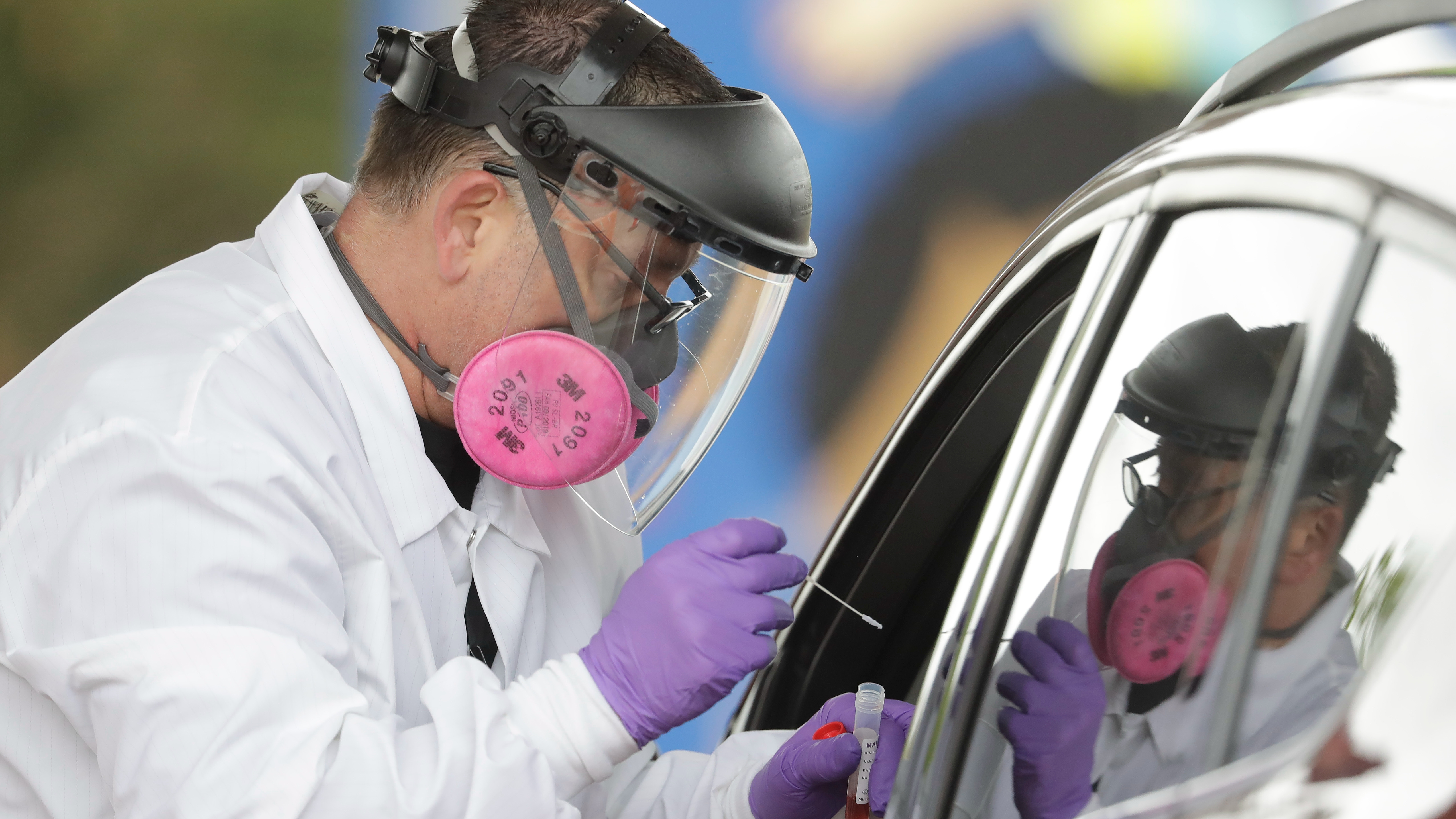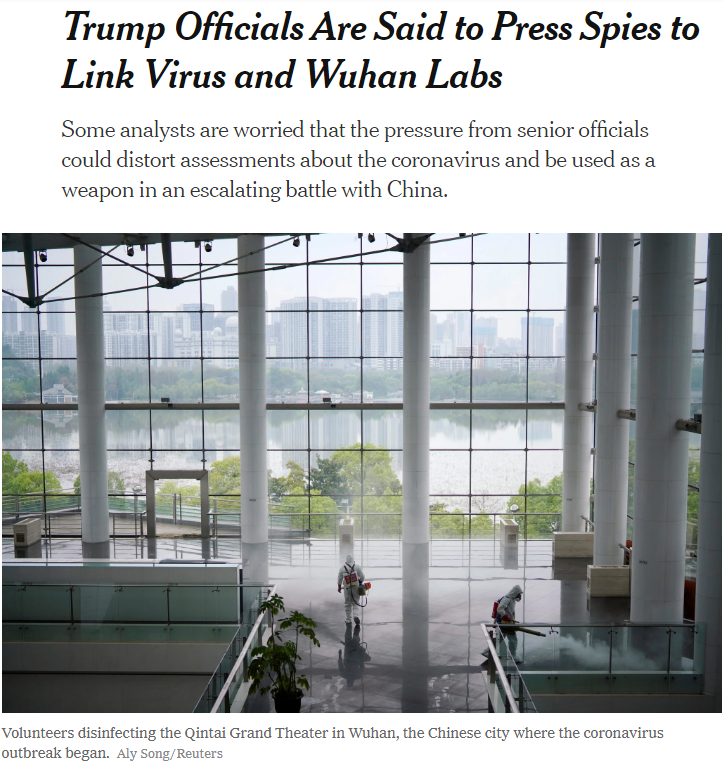
Christopher Ikemire prepares to test for the coronavirus at the Eastern Star Church in Indianapolis, April 30, 2020. /AP
Christopher Ikemire prepares to test for the coronavirus at the Eastern Star Church in Indianapolis, April 30, 2020. /AP
Editor's note: Hannan Hussain is an assistant researcher at the Islamabad Policy Research Institute (IPRI) and an author. The article reflects the author's opinions, not necessarily the views of CGTN.
An explosive report published by the New York Times states that senior Trump administration officials had been tightening the screws on U.S. spy agencies in a bid to sell the president's most beloved conspiracy: the COVID-19 stemmed from a lab in Wuhan. The effort, acknowledged as part of a larger design to politicize hostilities with China, was led by Washington's top national security brass, including deputy national security adviser Matthew Pottinger and Anthony Ruggiero, who heads the National Security Council's bureau for tracking weapons of mass destruction. Both officials share a history of twisting facts against China and are known to dismiss the resulting consequences as threat and intimidation campaigns.
According to the report, CIA analysts have repeatedly told Trump aides that they "did not have the evidence to support any one theory [linking the virus to Chinese labs]." The entire plot to pit U.S. intelligence machinery against Beijing was in motion since January – a timeline corresponding with Beijing's well-concentrated measures to contain the outbreak within its borders.
However, the Trump administration in January chose to short-circuit facts and fabricate a pattern of COVID-19 origins that pointed towards Wuhan. This confirms Washington's politicization of the pandemic since day one.
The NYT report also makes a larger point: Washington had considerable knowledge about the outbreak early on. Lead investigative reporters categorically state that since January, senior Trump officials and the CIA had been going back and forth, alternating stories and fetching leads that best fit the Trump administration's lab narrative. "The CIA's judgment was based in part on the fact that no signs had emerged that the Chinese government believed the outbreak came from a lab," states the report, adding that "the Chinese government has vigorously denied that the virus leaked from a lab."
Make no mistake, it's been months since Beijing first put that clarification on record, and the fact that American intelligence had been citing Beijing's reservations as a reason to contest potential evidence, suggests that both the CIA and Trump aides had been following the outbreak since its initial days. This debunks the myth that America has been mysteriously blindsided all this time.

A screenshot of The New York Times report.
A screenshot of The New York Times report.
The CIA's resistance to Trump's lab conspiracy pitch is not out of a love for impartiality either. It is this very agency that is actively involved in "tracking down information" on the lab theory and "frequently updating policymakers" as evidenced by the report. These signs dispel the possibility that intelligence officials were not on board with senior Trump aides. Their difficulty was to produce evidence that established the lab conspiracy objectively, given how the evidence never existed in the first place.
There is already an overarching consensus within the global scientific community that Chinese authorities had no link to the origins of the outbreak. A genetic analysis run by American scientists proved that the virus belonged from nature, taking the lid off Trump's insistence that the lab conspiracy held weight. Washington's policymaking and intelligence arms have also spent months ganging up on Beijing, dressing the latter's reactions to cover-up allegations as a "disinformation drive."
Secretary of State Mike Pompeo, whose role in the lab theory remains guarded by the report, went a step further to question China's COVID-19 statistics. In the report, he is revealed as the chief architect who pressed U.S. intelligence agencies to gather more information on the lab virus hoax, despite numerous research experts stating that "any type of laboratory-based scenario" just wasn't plausible.
This facade of U.S. exceptionalism – previously construed as China's own claim – was destined to disintegrate back home. The New York Times expose in this regard serves as a reasonable starting point for the Trump administration's own undoing.
It is also high time to retire another lousy U.S. rebuttal: reparations for China's alleged culpability. "Beijing could be sued for damages," suggests White House expert Michael Pillsbury, whose laughable reparation strategy laid the groundwork for Trump's newest obsession: Washington should seek "10 million U.S. dollars for every American death." This argument, driven by the government's domestic desperation, is a result of limited traction afforded by the global community to the Wuhan lab conspiracy itself. Moreover, the absence of an alternate blame-game tactic makes reparations from China a knee-jerk reaction.
The Wuhan Institute of Virology, a facility which U.S. government officials have spent months demonizing, is the same institute that shared the novel coronavirus' genome sequence with the World Health Organization. The institute has an established history of research partnerships both globally and with U.S. scientific communities – illustrating the scope, depth and legitimacy of its work.
It is no surprise that an administration which balks at the sound of empirical proof, ends up pitching the Wuhan institute's location as overarching evidence of COVID-19's genesis. Not long ago, it was Secretary of State Mike Pompeo who stated in an interview that his administration "knew" the Chinese government had considered the Wuhan Institute of Virology as the location of COVID-19's origins. If so, then why are efforts still underway to substantiate Washington's lab virus conspiracies and what prompted Pompeo's own Department to back his toxic assertions?
The explanation is simple: claims to knowledge are mere hyperbole, and Washington's lab fantasies are taking a good beating at the hands of its own press and officials.
(If you want to contribute and have specific expertise, please contact us at opinions@cgtn.com.)